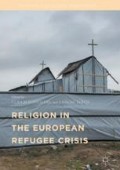Abstract
In the Introduction, Ulrich Schmiedel and Graeme Smith chart the context for the contributions to this compilation by scrutinizing the controversies stirred up by the conceptualization and characterization of the current situation of Europe as a crisis. Are the refugees in crisis? Are the receivers in crisis? Whose crisis was—or indeed is—it? While religion is a resource for refugees on the flight, Schmiedel and Smith argue, the public and political discourse about the current refugee crisis tells a decidedly different tale: it is a discourse about the receivers rather than a discourse about the refugees. In this discourse, religion appears as radically ambiguous, causing both social cohesion and social conflict in times of turmoil.
Notes
- 1.
United Nations High Commissioner for Refugees, UNHCR Global Appeal 2016–17 (Geneva: UNHCR, 2017), 6.
- 2.
See the UNHCR statistics at http://www.unhcr.org/figures-at-a-glance.html (accessed 06/2017).
- 3.
For a succinct summary of the Europeanization of migration policy , see Stefan Luft, Flucht nach Europa (Bonn: Bundeszentrale für politische Bildung, 2016), 47–69.
- 4.
Reece Jones, Violent Borders: Refugees and the Right to Move (London: Verso, 2016), 14.
- 5.
See https://missingmigrants.iom.int (accessed 06/2017).
- 6.
To understand the reasons for the suspension of the Dublin system (such as the maintenance of “Schengen”), see Herfried Münkler, “Die Mitte und die Flüchtlingskrise. Über Humanität, Geopolitik und innenpolitische Folgen der Aufnahmeentscheidung,” Aus Politik und Zeitgeschichte 66 (2016), 3–8. According to the Court of Justice of the European Union, the Dublin System has not ceased to be in force. States are allowed, however, to accept additional applications for asylum. See the Court’s press releases from July 26, 2017, available at https://curia.europa.eu/jcms/ (accessed 07/2017).
- 7.
Reinhart Kosellek, “Crisis” (trans. Michaela W. Richter), Journal of the History of Ideas 67/2 (2006), 357–400.
- 8.
See ibid., 381.
- 9.
See ibid., 389–392.
- 10.
Luft, Flucht nach Europa, 8 (our translation).
- 11.
See ibid., 8–9.
- 12.
See United Nations High Commissioner for Refugees, Global Appeal 2016–17, 18.
- 13.
For a short summary, see Luft, Flucht nach Europa, 26–37.
- 14.
Jones, Violent Borders, 27.
- 15.
Zygmunt Bauman, Strangers at Our Door (Cambridge: Polity Press, 2016), 1.
- 16.
Ibid., 3.
- 17.
For the variations in the modes of migration, see the political theory of migration developed by Thomas Nail, The Figure of the Migrant (Stanford: Stanford University Press, 2015).
- 18.
Thomas Nail, “A Tale of Two Crises: Migration and Terrorism after the Paris Attacks,” Studies in Ethnicity and Nationalism 16/1 (2016), 160.
- 19.
Marianne Heimbach-Steins, Grenzverläufe gesellschaftlicher Gerechtigkeit (Paderborn: Schöningh, 2016), 39–58, points to colonialism as both the cause and the consequence of the policies of migration in the European Union. She elaborates on philosophical and theological criteria for a postcolonial ethics of migration, rooted in motifs and metaphors of the Bible . See ibid., 59–98. See also Marianne Heimbach-Steins, “Migration in a Post-Colonial World,” in Religious and Ethical Perspectives on Global Migration, eds. Elizabeth W. Collier and Charles R. Strain (Lanham: Lexington, 2014), 87–108.
- 20.
For a succinct summary, see David Hollenbach, S.J., “Religion and Forced Migration,” in The Oxford Handbook of Refugee and Forced Migration Studies, eds. Elena Fiddian-Qasmiyeh, Gil Loescher, Katy Long, and Nando Sigona (Oxford: Oxford University Press, 2014), 447–459.
- 21.
José Casanova, “Rethinking Secularization,” The Hedgehog Review Spring/Summer (2006), 17.
- 22.
See José Casanova, Europas Angst vor der Religion (Berlin: Berlin University Press, 2009).
- 23.
See especially Intersections of Religion and Migration: Issues at the Global Crossroads, eds. Jennifer B. Saunders, Elena Fiddian-Qasmiyeh, and Susanna Snyder (New York: Palgrave Macmillan, 2016); Church in an Age of Global Migration: A Moving Body, eds. Susanna Snyder, Joshua Ralston, and Agnes M. Brazal (New York: Palgrave Macmillan, 2016); Religion, Migration, and Identity: Methodological and Theological Explorations, eds. Martha Frederiks and Dorottya Nagy (Leiden: Brill, 2016). The significance of theology for the study of religion and migration is stressed in a trilogy consisting of Contemporary Issues of Migration and Theology, eds. Elaine Padilla and Peter C. Phan (New York: Palgrave Macmillan, 2013); Theology of Migration in the Abrahamic Religions, eds. Elaine Padilla and Peter C. Phan (New York: Palgrave Macmillan, 2014); and Christianities in Migration: The Global Perspective, eds. Elaine Padilla and Peter C. Phan (New York: Palgrave Macmillan, 2016).
- 24.
Most of the literature on the current European refugee crisis is not concerned with religion, while most of the literature on religion is not concerned with the current European refugee crisis. However, a number of contributions to The Refugee Crisis and Religion: Secularism, Security and Hospitality in Question, eds. Luca Mavelli and Erin Wilson (London: Rowman & Littlefield, 2016), are exemplary exceptions to this rule.
- 25.
Susanna Snyder, Asylum-Seeking, Migration, and Church (London: Routledge, 2016).
Author information
Authors and Affiliations
Editor information
Editors and Affiliations
Rights and permissions
Copyright information
© 2018 The Author(s)
About this chapter
Cite this chapter
Schmiedel, U., Smith, G. (2018). Introduction: Charting a Crisis. In: Schmiedel, U., Smith, G. (eds) Religion in the European Refugee Crisis. Religion and Global Migrations. Palgrave Macmillan, Cham. https://doi.org/10.1007/978-3-319-67961-7_1
Download citation
DOI: https://doi.org/10.1007/978-3-319-67961-7_1
Published:
Publisher Name: Palgrave Macmillan, Cham
Print ISBN: 978-3-319-67960-0
Online ISBN: 978-3-319-67961-7
eBook Packages: Religion and PhilosophyPhilosophy and Religion (R0)

